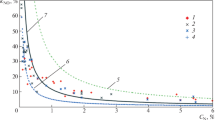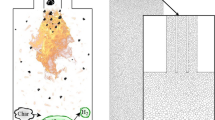The main mechanisms of formation and suppression of sulfur oxides during combustion of solid fuels in a CFB and the main regime factors affecting the concentration of sulfur oxides during air combustion are considered. Features are demonstrated for mechanisms of formation and suppression of sulfur oxide emissions during combustion with oxygen, which are largely associated with a high partial pressure of carbon dioxide mixed with oxygen. Comparative analysis of the effect of entrapping SOx and regime factors during combustion of oxygen and CO2 in air and the environment is performed. The most preferred mathematical models for calculating SOx emissions are given and the calculated results are compared with experimental data. Directions and approaches for further research are indicated, primarily in the direction of modeling under conditions of combined combustion of coal and biomass. It is shown that it is important to conduct comprehensive studies of processes for formation and suppression of harmful emissions from combined combustion of coal and various types of biomass, especially when burning in an oxygen atmosphere with CO2 recirculation.
Similar content being viewed by others
References
T. Czakiert, J. Zuwala, and J. Lasek, “Oxy-fuel combustion: The state of the art,” in: Proc. of 12th Int. Conf. on Fluidized Bed Technology, Kraków, Poland (2017).
A. Hotta, K. Nuortimo, T. Eriksson, J. Palonen, and S. Kokki, “CFB technology provides solutions to combat climate change, Foster Wheeler Energia Oy. Plenary lecture,” in: CFB-9 Conference (2008).
R. Hughes, L. Jia, Y. Tan, E. Anthony, and A. Macchi, “Oxy-fuel combustion of coal in a circulating fluidized bed combustor,” in: Proc. of the 19th Int. Conf. on FBC, Vienna, Austria (2006).
G. A. Ryabov, O. Folomeev, D. Sankin, K. Khaneev, N. Bondarenko, and D. Mel’nikov, “Use of CDB technology for large power generation units and CO2 capture,” Élektr. Stantsii, No. 2, 2 – 11 (2010).
G. Jukkola, G. Liljedahl, N. Nsakala, J. X. Morin, and H. Andrus, “An Alstom vision of future CFB technology based power plant concepts,” in: Proc. of the 18th Int. Conf. on Fluidized Bed Combustion, Toronto, Canada (2005).
T. Eriksson Eriksson “Development and demonstration of flexiburn CFB technology,” in: Seminar on Carbon Capture and Storage, Espoo, Finland, November (2010). https://www.vtt.fi/files/projects/ccsfinland/seminaari2010/11-eriksson.pdf.
E. J. Anthony and D. L. Granatstein, “Sulfation phenomena in fluidized bed combustion systems,” Progr. Energy Combustion Sci., 27(2), 215 – 236 (2001). https://doi.org/10.1016/S0360-1285(00)00021-6.
B. Leckner, “Optimization of emission from fluidized bed boilers,” Int. J. Energy Res., 16(5), 351 – 356 (1992).
J. F. Li1, J. H. Mi1, J. H. Hao, et al., “Operational status of 300 MW CFB boiler in China,” in: Proc. of Int. Conf. FBC 20, May 18 – 21, 2009, Xian, China (2009).
E. Antonenko, et. al., “Startup the first 330 MW CFB unit in Russia at Novocherkasskay TPP,” in: Proc. of 12th Int. Conf. on CFB, May 23 – 26, 2017, Krakow, Poland (2017).
H. Liu, S. Katagiri, U. Kaneko, et al., “Sulfation behavior of limestone under high CO2 concentration in O2/CO2 coal combustion,” Fuel, 79(8), 945 – 953 (2000). https://doi.org/10.1016/S0016-2361(99)00212-4.
M. J. H. Snow, J. P. Longwell, and A. F. Sarofim, “Direct sulfation of calcium carbonate,” Industr. Eng. Chem. Res., 27(2), 268 – 273 (1988).
F. Garcia-Labiano, E. Hamparlsoumian, and A. Williams, “Determination of sulfur release and its kinetics in rapid pyrolysis of coal,” Fuel, 74(7), 1072 – 1079 (1995).
Luning Turn, Hanping Chen, Zhenluii Chen, Wei Yang, Haiping Yang, and Xiannua Wang, Behavior of SO2emission and removal during coal combustion in oxy-fuel CFB condition. Technical Report of State key laboratory of coal combustion, Huazhong University of Science and Technology, Wuhan, China (2010).
C. Lupiáñez, L. I. Díez, and L. M. Romeo, “Influence of gasstaging on pollutant emissions from fluidized bed oxy-firing,” Chem. Eng. J., No. 256, 380 – 389 (2014).
Y. Tan, L. Jia, Y. Wu, and E. Anthony, “Experiences and results on a 0.8 MWth oxy-fuel operation pilot-scale circulating fluidized bed,” Appl. Energy, No. 92, 343 – 347 (2012).
M. De Las Obras-Loscertales, L. De Diego, F. García-Labiano, A. Rufas, A. Abad, P. Gayán, and J. Adánez, “Sulfur retention in an oxy-fuel bubbling fluidized bed combustor: Effect of coal rank, type of sorbent and O2/CO2 ratio,” Fuel, No. 137, 384 – 392 (2014).
Y. Li, H. Qi, and J. Wang, “SO2 capture and attrition characteristics of a CaO/biobased sorbent,” Fuel, No. 93, 258 – 263 (2012).
Y. Mathieu, L. Tzanis, M. Soulard, J. Patarin, M. Vierling, and M. Molière, “Adsorption of SOx by oxide materials: A review,” Fuel Process. Technol., No. 114, 81 – 100 (2014).
M. Varol, A. T. Atimtay, H. Olgun, and H. Atakül, “Emission characteristics of co-combustion of a low calorie and high sulfur- lignite coal and woodchips in a circulating fluidized bed combustor: Part 1. Effect of excess air ratio,” Fuel, No. 117, 792 – 800 (2014).
A. Magdziarz, M. Wilk, and M. Zajemska, “Modelling of pollutants concentrations from the biomass combustion process,” Chem. Process Eng., No. 32, 423 – 433 (2011).
D. M. Zajemska, H. Radomiak, and A. Poskart, “Formation of pollutants in the process of co-combustion of different biomass grades,” Pol. J. Environ., No. 23, 1445 – 1448 (2014).
M. Zajemska and A. Poskart, “The impact of co-firing sunflower husk pellets with coal in a boiler on the chemical composition of flue gas,” Energy Fuel, No. 14 (2017).
Author information
Authors and Affiliations
Corresponding author
Additional information
Translated from Élektricheskie Stantsii, No. 8, August 2019, pp. 18 – 24.
Rights and permissions
About this article
Cite this article
El-Sheikh, K., Ryabov, G.A. & Bukharkina, T.V. Features of Formation and Suppression of Sulfur Oxide Emissions During Burning Fuels in an Oxygen Medium With CO2 Recirculation. Power Technol Eng 53, 585–590 (2020). https://doi.org/10.1007/s10749-020-01120-2
Published:
Issue Date:
DOI: https://doi.org/10.1007/s10749-020-01120-2




